Research on the Impact of Water Conservancy Projects on Downstream Floodplain Wetlands—Taking Yimin River as an Example
Abstract
:1. Introduction
2. Study Area and Data
2.1. Study Area
2.2. Data Source and Processing
3. Methodology
3.1. Technical Process
3.2. Water-Body Extraction Method
3.3. Water Inundation Guarantee Rate
3.4. Double Cumulative Curve Method
4. Results
4.1. Water-Inundation Area
4.2. Water Inundation Guarantee Rate
5. Discussion
5.1. Evaluation System
5.2. Changes in Rainfall, Runoff and Inundation
5.3. Longitudinal Distribution Features of the Affected Wetlands
5.4. Horizontal Distribution Characteristics of Rivers in the Affected Wetlands
6. Conclusions
- (1)
- This study assesses the spatial impact of water conservancy project construction on floodplain wetlands based on the WIGR model. This study is the application of the WIGR model, which will have broad application prospects in floodplain wetland biodiversity, ecosystem stability, conservation area delimitation, etc., but there are also some defects such as the impact of remote sensing data cloud and rain, the number of remote sensing data, and the accuracy of hydrological data that will have an impact on the application of WIGR model in floodplain wetland;
- (2)
- After the construction of Honghuaerji Reservoir, the hydrological situation of the Yimin River was affected, and the runoff of the Yimin River will decrease, the predictability of the runoff will become worse, and the flow of the river will decrease, affecting the floodplain wetlands, reducing the frequency of river inundation, and resulting in a reduction in the coverage area of the inundation guarantee rate after the construction of the reservoir; the construction of the reservoir has changed the natural runoff process of the river, making the hydrological situation of the river tend to be stable and uniform, making the flow stable, resulting in an increase in the area with a very high inundation guarantee rate in the river channel;
- (3)
- The surrounding area of the high-curvature reaches is the main development area of floodplain wetlands, and is also the main area affected by hydrological changes;
- (4)
- The construction of the reservoir reduces the flow loss and the exchange of lateral water bodies, resulting in a negative impact on the hydrological status of the floodplain wetland, the area of the floodplain outside the river channel is reduced, the hydrological situation in the river channel has changed due to the influence of the dam, and the reservoir has changed. A regulated base flow or low flow will increase its inundation frequency, resulting in increased coverage of high inundation guaranteed rates.
Author Contributions
Funding
Institutional Review Board Statement
Informed Consent Statement
Data Availability Statement
Conflicts of Interest
References
- Finlayson, C.M. Wetland types and their distribution in northern Australia. Max Finlayson Abbie Spiers 1999, 21. [Google Scholar]
- Wilson, J.W. Conservation Planning in a Changing World: Mitigating the Deleterious Effects of Habitat Loss. Ph.D. Thesis, North Carolina State University, Raleigh, NC, USA, 2014. [Google Scholar]
- Zedler, J.B.; Kercher, S. Wetland resources: Status, trends, ecosystem services, and restorability. Annu. Rev. Environ. Resour. 2005, 30, 39–74. [Google Scholar] [CrossRef] [Green Version]
- Hockings, M. Evaluating protected area management: A review of systems for assessing management effectiveness of protected areas. Sch. Nat. Rural. Syst. Occas. Paper. 2000, 7, 56. [Google Scholar]
- Ren, G.; Young, S.S.; Wang, L.; Wang, W.; Long, Y.; Wu, R.; Li, J.; Zhu, J.; Douglas, W.Y. The Effectiveness of China’s National Forest Protection Program and National-level Nature Reserves, 2000 to 2010. Conservation Biology 2015, 29, 1368–1377. [Google Scholar] [CrossRef] [PubMed] [Green Version]
- Chen, J.; Shi, H.; Sivakumar, B.; Peart, M. Population, water, food, energy and dams. Renew. Sustain. Energy Rev. 2016, 56, 18–28. [Google Scholar] [CrossRef]
- Pal, S. Impact of water diversion on hydrological regime of the Atreyee river of Indo-Bangladesh. Int. J. River Basin Manag. 2016, 14, 459–475. [Google Scholar] [CrossRef]
- Pal, S.; Sarda, R.J. Damming effects on the degree of hydrological alteration and stability of wetland in lower Atreyee River basin. Ecol. Indic. 2020, 116C, 106542. [Google Scholar] [CrossRef]
- Pekel, J.F.; Cottam, A.; Gorelick, N.; Belward, A. High-resolution mapping of global surface water and its long-term changes. Nature 2016, 540, 418–422. [Google Scholar] [CrossRef]
- Chaparro, G.; O’Farrell, I.; Hein, T. Multi-scale analysis of functional plankton diversity in floodplain wetlands: Effects of river regulation. Sci. Total Environ. 2019, 667, 338–347. [Google Scholar] [CrossRef]
- Van Dam, R.A.; Camilleri, C.; Finlayson, C.M. The potential of rapid assessment techniques as early warning indicators of wetland degradation: A review. Environ. Toxicol. Water Qual. Int. J. 1998, 13, 297–312. [Google Scholar] [CrossRef]
- Yanites, B.J.; Ehlers, T.A.; Becker, J.K.; Schnellmann, M.; Heuberger, S. High magnitude and rapid incision from river capture: Rhine River, Switzerland. J. Geophys. Res. Earth Surf. 2013, 118, 1060–1084. [Google Scholar] [CrossRef] [Green Version]
- Debanshi, S.; Pal, S.J. Wetland delineation simulation and prediction in deltaic landscape. Ecol. Indic. 2021, 108, 105757.1–105757.14. [Google Scholar] [CrossRef]
- Foody, G.M. Status of land cover classification accuracy assessment. Remote Sens. Environ. 2002, 80, 185–201. [Google Scholar] [CrossRef]
- McFeeters, S.K. The use of the Normalized Difference Water Index (NDWI) in the delineation of open water features. Int. J. Remote Sens. 1996, 17, 1425–1432. [Google Scholar] [CrossRef]
- Oliveira, A.G.; Baumgartner, M.T.; Gomes, L.C.; Dias, R.M.; Agostinho, A.A. Long-term effects of flow regulation by dams simplify fish functional diversity. Freshw. Biol. 2018, 63, 293–305. [Google Scholar] [CrossRef]
- Wen, L.; Macdonald, R.; Morrison, T.; Hameed, T.; Saintilan, N.; Ling, J. From hydrodynamic to hydrological modelling: Investigating long-term hydrological regimes of key wetlands in the Macquarie Marshes, a semi-arid lowland floodplain in Australia. J. Hydrol. 2013, 500, 45–61. [Google Scholar] [CrossRef]
- Sanyal, J. Predicting possible effects of dams on downstream river bed changes of a Himalayan river with morphodynamic modelling. Quat. Int. 2017, 453, 48–62. [Google Scholar] [CrossRef]
- Zeng, X.; Yang, X.; Yu, L.; Chen, H. A Mix Inexact-Quadratic Fuzzy Water Resources Management Model of Floodplain (IQT-WMMF) for Regional Sustainable Development of Dahuangbaowa, China. Water 2015, 7, 2771–2795. [Google Scholar] [CrossRef] [Green Version]
- Zeng, X.; Huang, G.; Chen, H.; Li, Y.; Kong, X.; Fan, Y. A simulation-based water-environment management model for regional sustainability in compound wetland ecosystem under multiple uncertainties. Ecol. Model. 2016, 334, 60–77. [Google Scholar] [CrossRef]
- Zeng, X.; Huang, G.; Yang, X.; Wang, X.; Fu, H.; Li, Y.; Li, Z. A developed fuzzy-stochastic optimization for coordinating human activity and eco-environmental protection in a regional wetland ecosystem under uncertainties. Ecol. Eng. 2016, 97, 207–230. [Google Scholar] [CrossRef]
- Zeng, X.; Zhao, J.; Yang, X.; Wang, X.; Xu, C.; Cui, L.; Zhou, Y. A land-indicator-based optimization model with trading mechanism in wetland ecosystem under uncertainty. Ecol. Indic. 2017, 74, 479–499. [Google Scholar] [CrossRef]
- Zuo, D.; Luo, P.; Yang, H.; Mou, C.; Li, Y.; Mo, L.; Li, T.; Luo, C.; Li, H.; Wu, S. Assessing the Space Neighborhood Effects and the protection Effectiveness of a Protected Area-a Case Study from Zoige Wetland National Nature Reserve. Chin. J. Appl. Environ. Biol. 2019, 25, 0854–0861. [Google Scholar]
- Lu, C.; Wang, Z.; Liu, M.; Ouyang, L.; Jia, M.; Mao, D. Analysis of conservation effectiveness of wetland protected areas based on remote sensing in West Songnen Plain. China Environ. Sci. 2015, 35, 599–609. [Google Scholar]
- Dong, X.; Hu, C. A new method for describing the inundation status of floodplain wetland. Ecol. Indic. 2021, 131, 108144. [Google Scholar] [CrossRef]
- Zeng, X.; Zhang, S.; Li, T.; Xue, Y.; Zhao, J.; Fu, Y.; Zhang, J.; Chen, C.; Kong, X.; Zhang, J. A risk-simulation based optimization model for wetland reallocation on Yongding floodplain, China. Ecol. Indic. 2021, 123, 107342. [Google Scholar] [CrossRef]
- Murray, N.J.; Phinn, S.R.; DeWitt, M.; Ferrari, R.; Johnston, R.; Lyons, M.B.; Clinton, N.; Thau, D.; Fuller, R.A. The global distribution and trajectory of tidal flats. Nature 2018, 565, 222–225. [Google Scholar] [CrossRef]
- Xu, H. Research on the use of improved normalized differential water index (MNDWI) to extract water information. J. Remote Sens. 2005, 9, 589–595. [Google Scholar]
- Feyisa, G.L.; Meilby, H.; Fensholt, R.; Proud, S.R. Automated Water Extraction Index: A new technique for surface water mapping using Landsat imagery. Remote Sens. Environ. 2014, 140, 23–35. [Google Scholar] [CrossRef]
- Pinel, S.; Bonnet, M.P.; Silva, J.; Catry, T.; Seyler, F. Flooding Dynamics Within an Amazonian Floodplain: Water Circulation Patterns and Inundation Duration. Water Resour. Res. 2020, 56. [Google Scholar] [CrossRef] [Green Version]
- Yi, S. Research on the impact of climate change and human activities on hydrology and water resources in the Daling River Basin. Water Conserv. Plan. Des. 2018, 4, 61–63. [Google Scholar]
- He, T.; Xiao, W.; Zhao, Y.L.; Chen, W.; Zhang, J. Continues monitoring of subsidence water in mining area from the eastern plain in china from 1986 to 2018 using Landsat imagery and Google Earth Engine. J. Clean. Prod. 2020, 279, 123610. [Google Scholar] [CrossRef]
- Richter, B.D.; Baumgartner, J.V.; Powell, J.; Braun, D.P. A Method for Assessing Hydrologic Alteration within Ecosystems. Conserv. Biol. 1996, 10, 1163–1174. [Google Scholar] [CrossRef] [Green Version]
- Alcayaga, H.; Palma, S.; Caamaño, D.; Mao, L.; Soto-Alvarez, M. Detecting and quantifying hydromorphology changes in a chilean river after 50 years of dam operation. J. South Am. Earth Sci. 2019, 93, 253–266. [Google Scholar] [CrossRef]
- Jia, M.; Mao, D.; Wang, Z.; Ren, C.; Zhu, Q.; Li, X.; Zhang, Y. Tracking long-term floodplain wetland changes: A case study in the China side of the Amur River Basin. Int. J. Appl. Earth Obs. Geoinf. 2020, 92, 102185. [Google Scholar] [CrossRef]
- Lanzoni, S.; Ferdousi, A.; Tambroni, N. River banks and channel axis curvature: Effects on the longitudinal dispersion in alluvial rivers. Adv. Water Resour. 2018, 113, 55–72. [Google Scholar] [CrossRef] [Green Version]
- Mera, I.; Franca, M.; Anta, J.; Peña, E. Turbulence anisotropy in a compound meandering channel with different submergence conditions. Adv. Water Resour. 2014, 81, 142–151. [Google Scholar] [CrossRef]
- Ablat, X.; Liu, G.; Liu, Q.; Huang, C. Application of Landsat derived indices and hydrological alteration matrices to quantify the response of floodplain wetlands to river hydrology in arid regions based on different dam operation strategies. Sci. Total Environ. 2019, 688, 1389–1404. [Google Scholar] [CrossRef]
- Karim, F.; Marvanek, S.; Wallace, J.; Petheram, C.; Ticehurst, C.; Gouweleeuw, B. The Use of Hydrodynamic Modelling and Remote Sensing to Assess Hydrological Connectivity of Floodplain Wetlands. In Proceedings of the Hydrology and Water Resources Symposium 2012, Barton, ACT, Australia, 9–12 November 2012; pp. 1334–1341. [Google Scholar]
- Chen, L.; Wu, Y.; Xu, Y.J.; Zhang, G. Alteration of flood pulses by damming the Nenjiang River, China–Implication for the need to identify a hydrograph-based inundation threshold for protecting floodplain wetlands. Ecol. Indic. 2021, 124, 107406. [Google Scholar] [CrossRef]

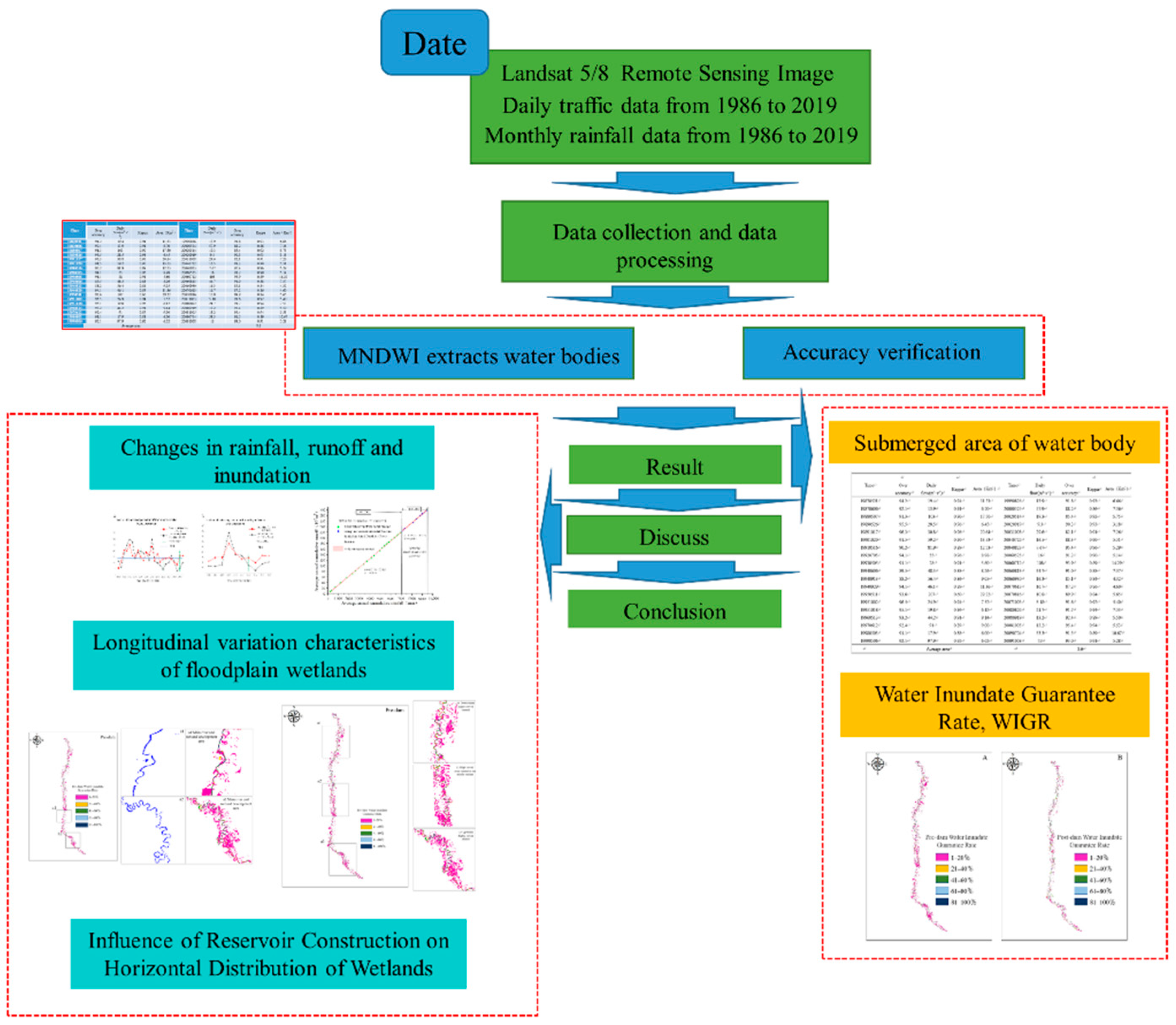
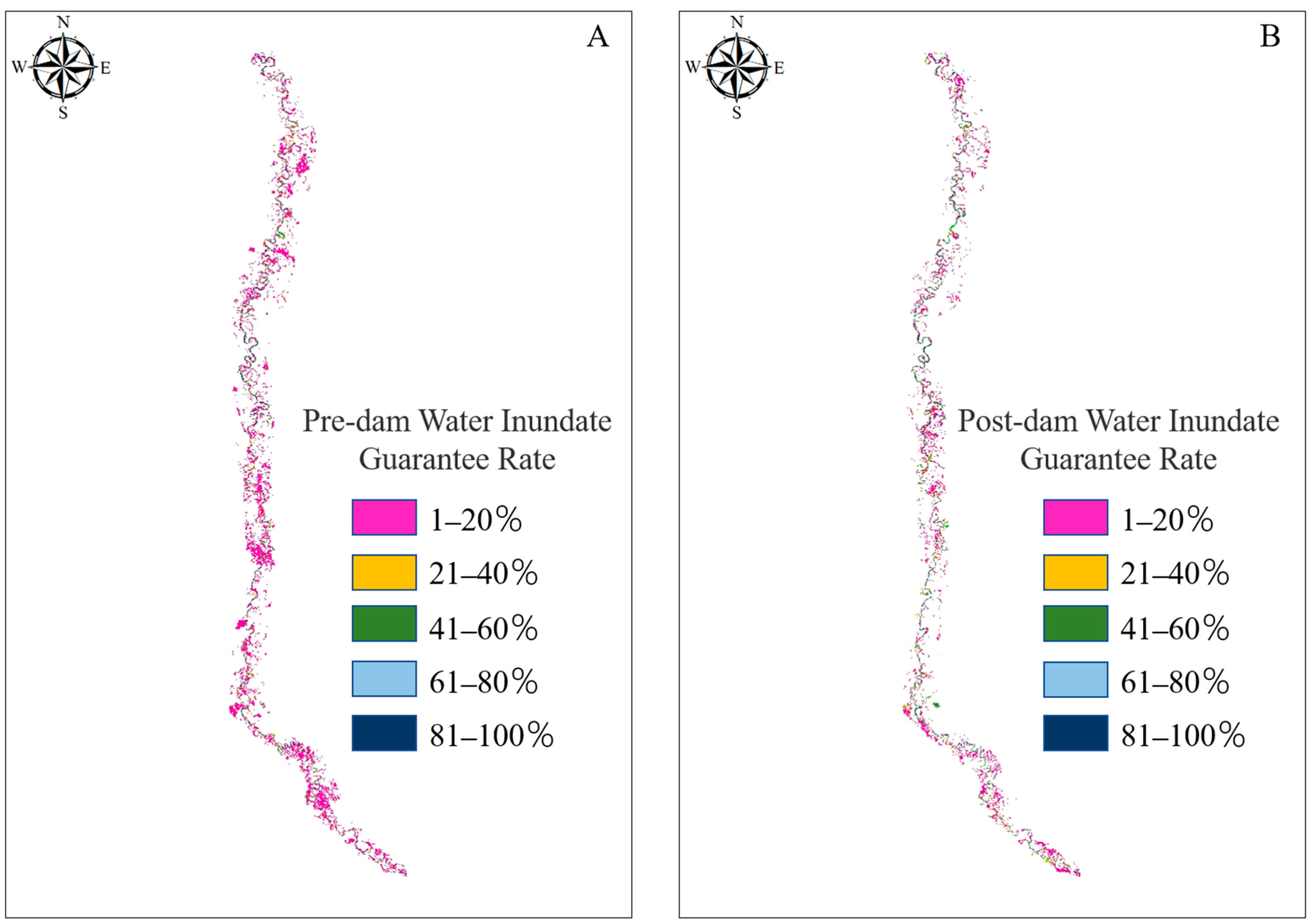

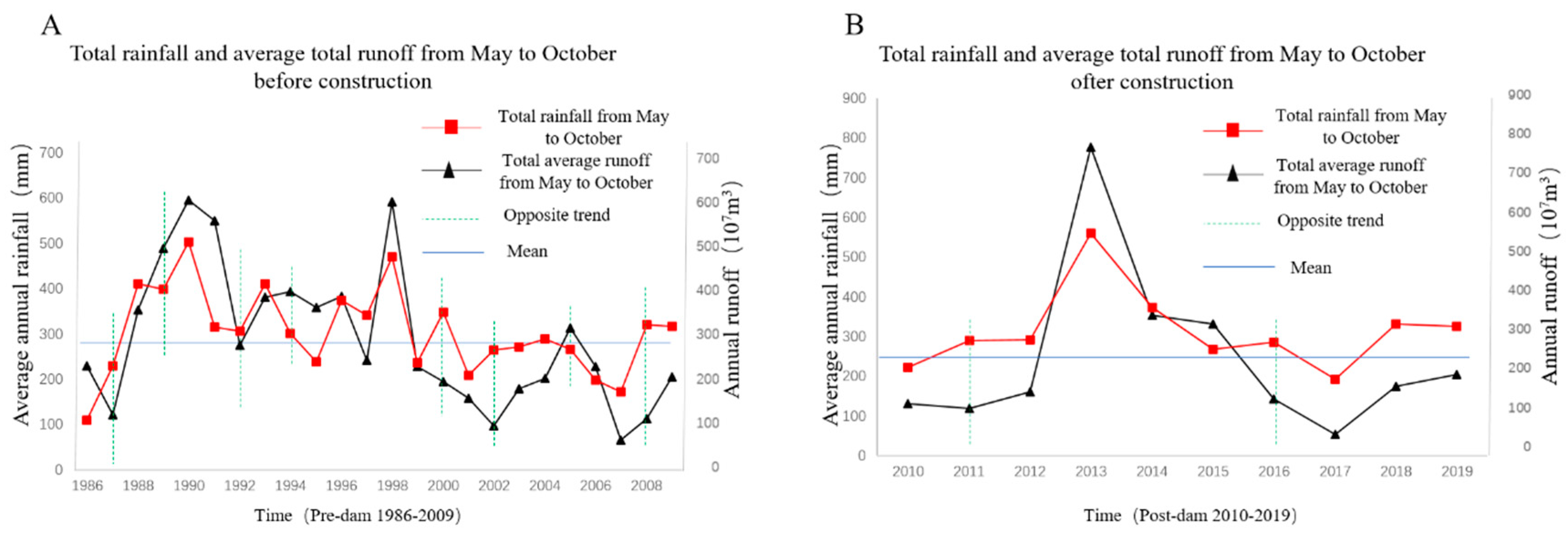
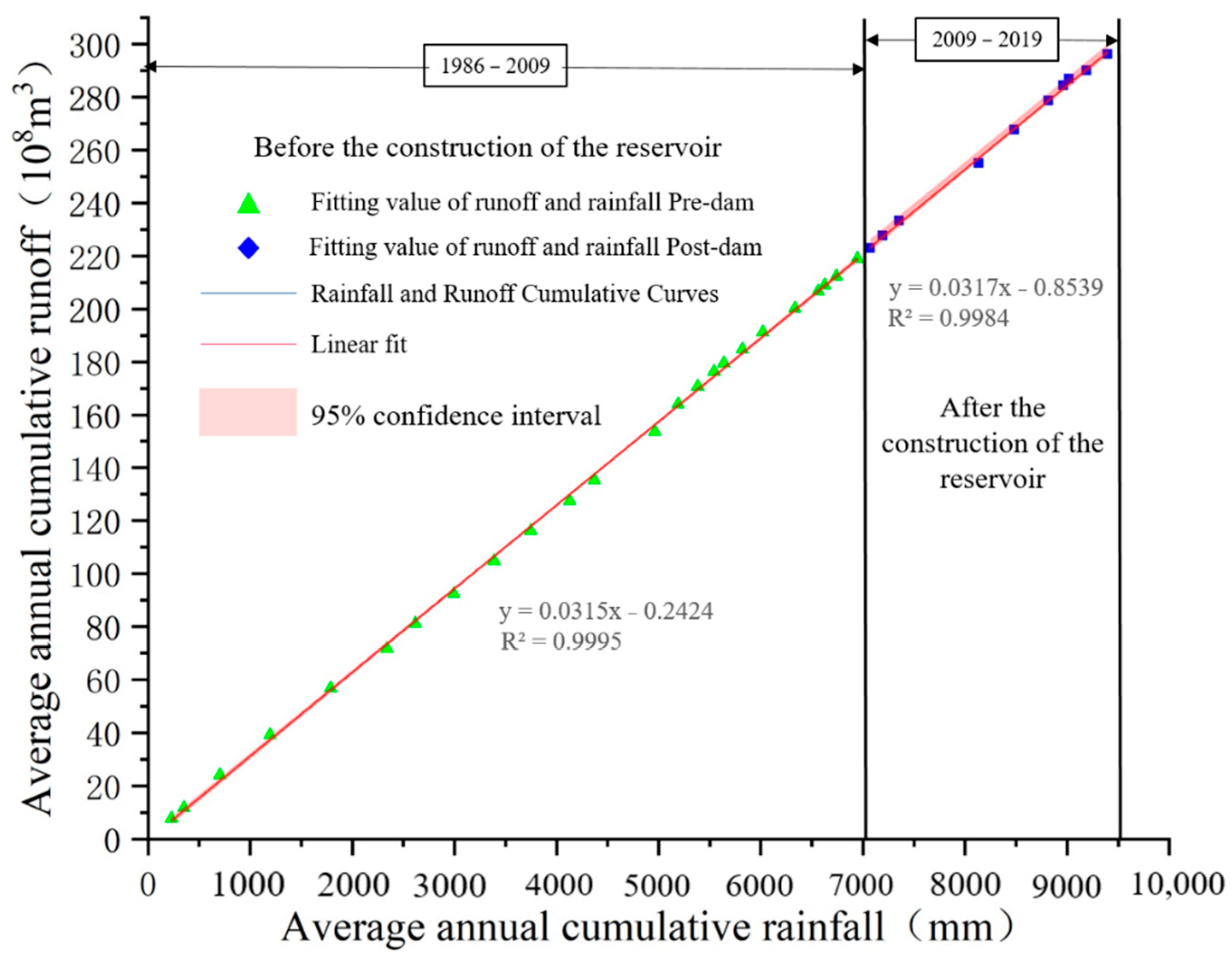
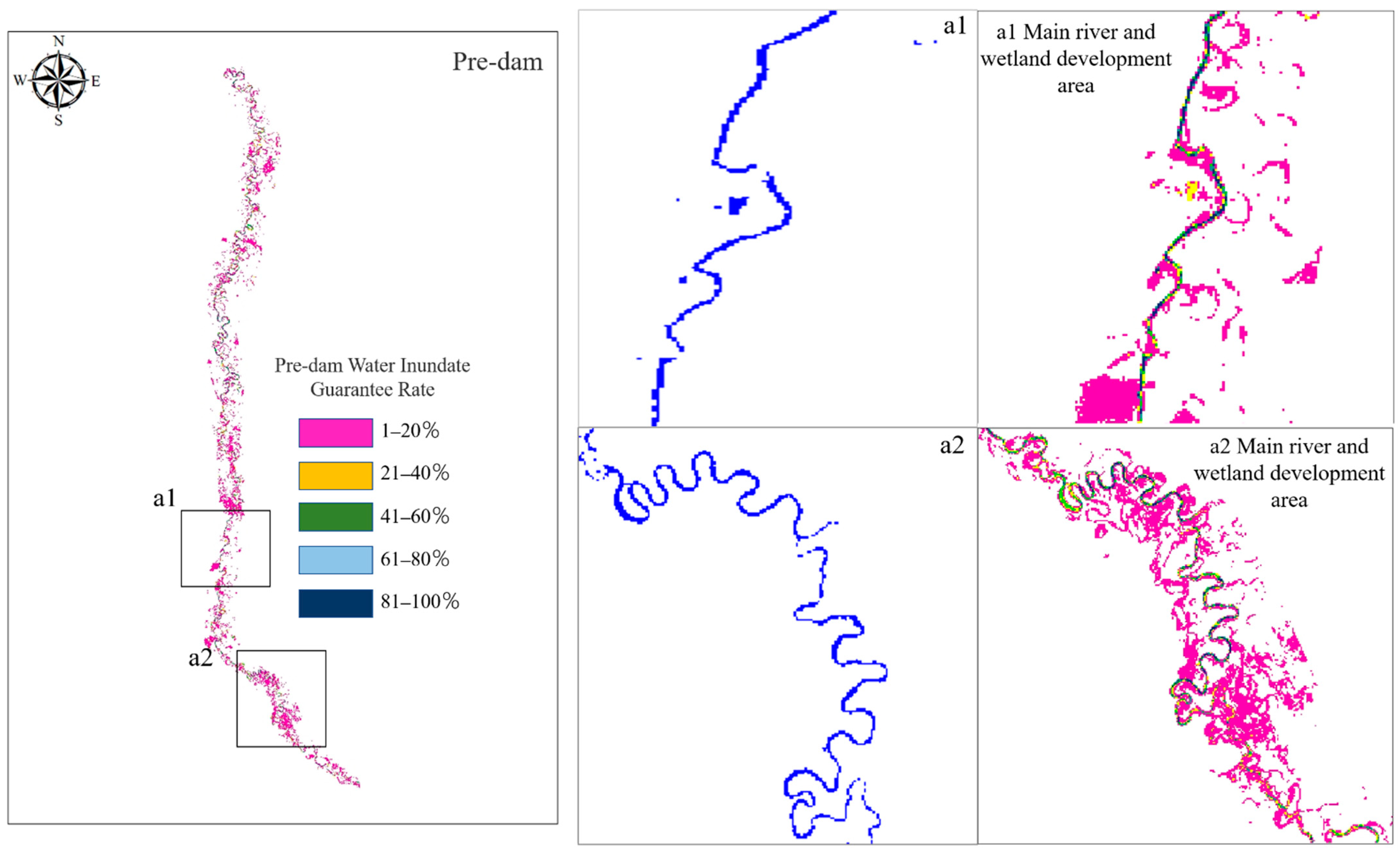
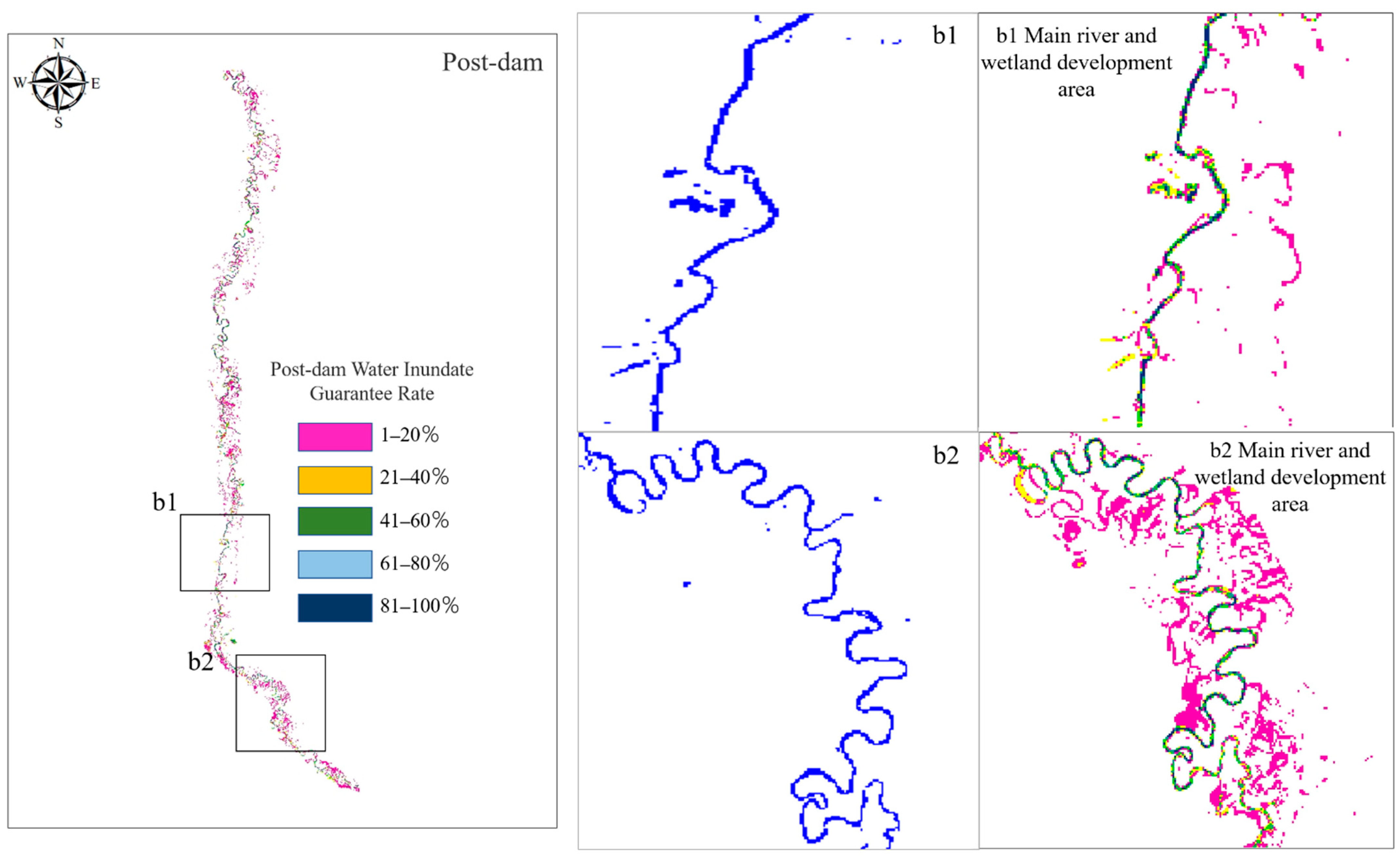
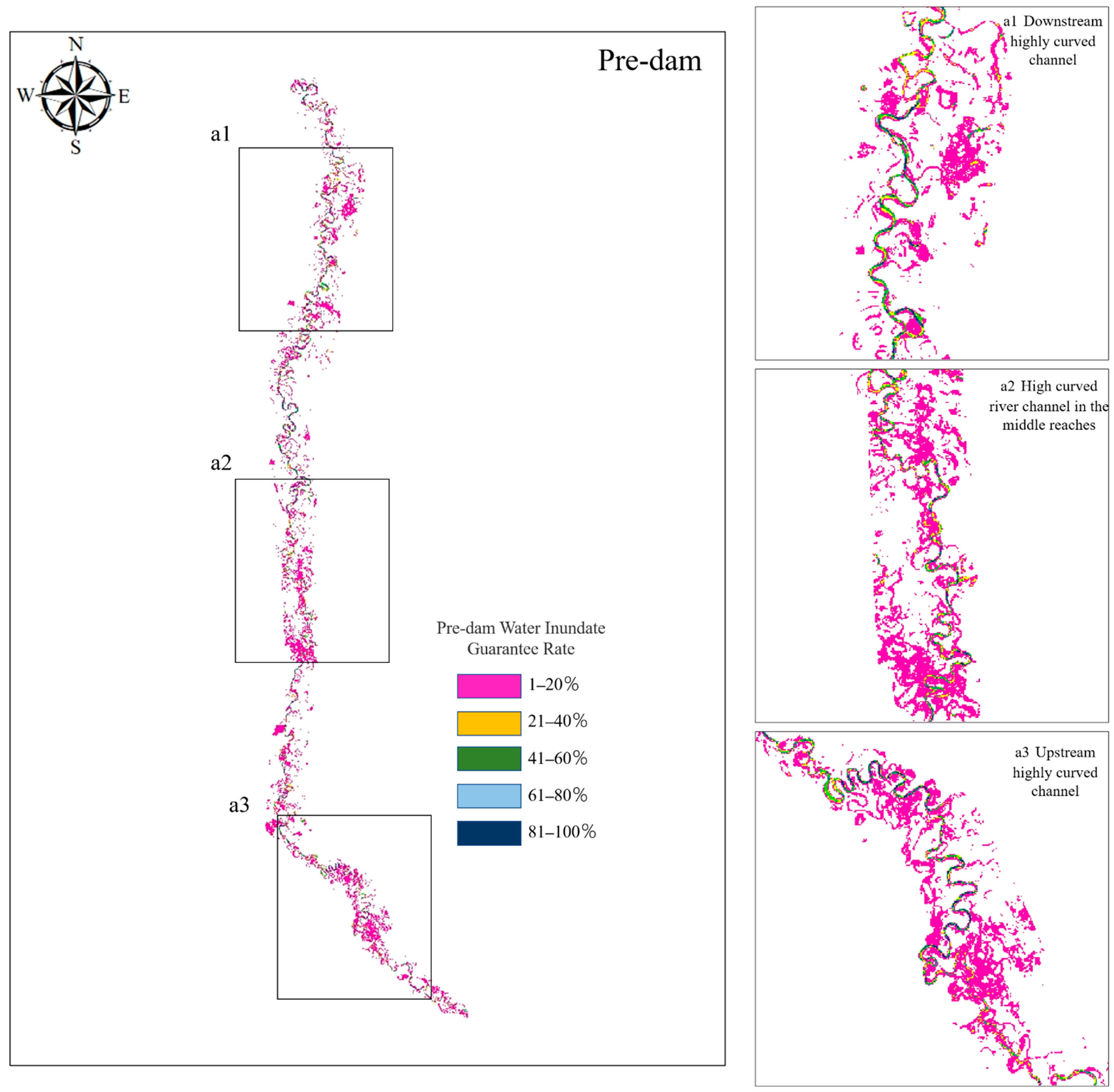
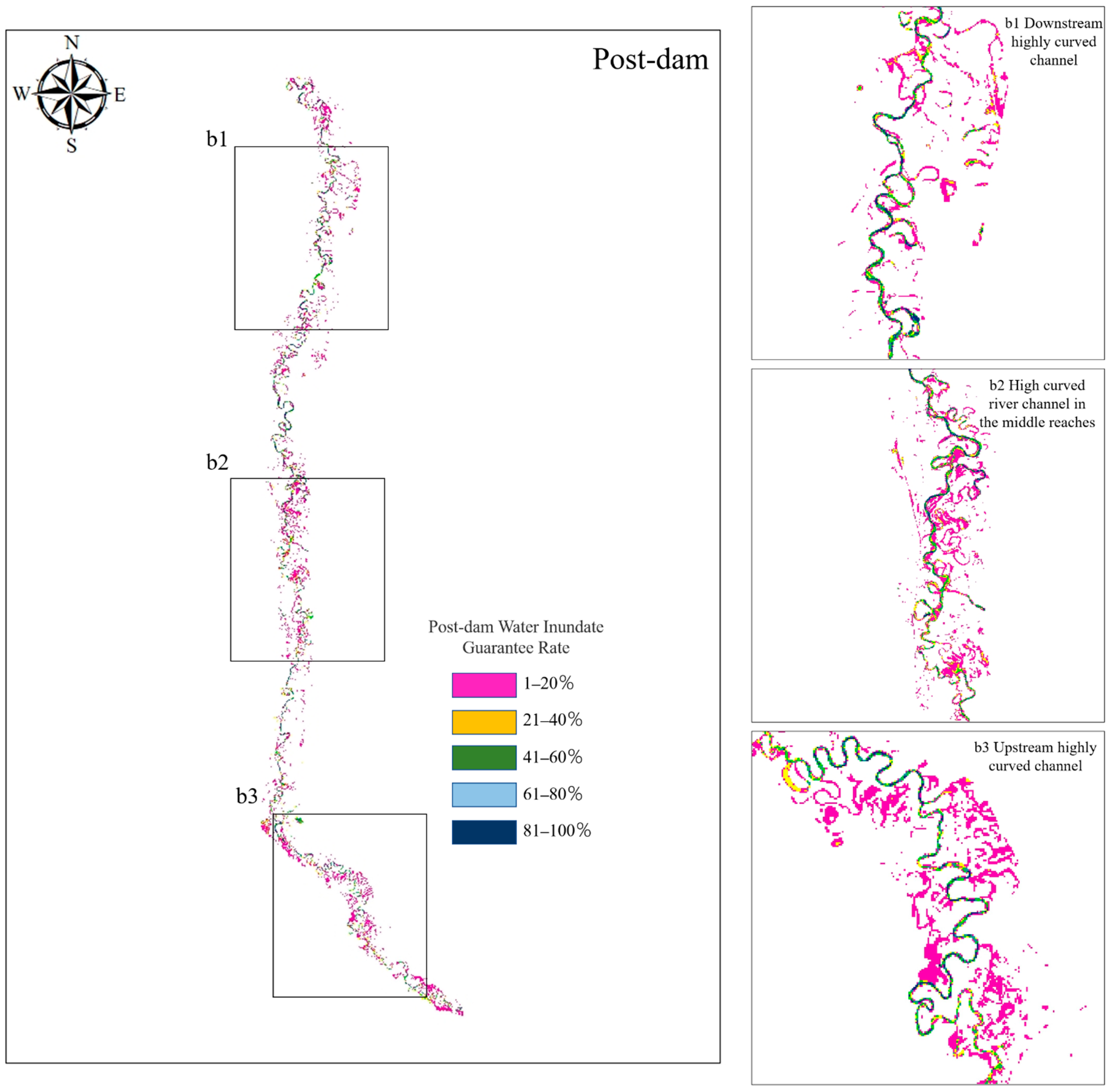

| Satellite | Band | Nominal Spectral Location | Satellite | Band | Nominal Spectral Location |
|---|---|---|---|---|---|
| Landsat5 TM | 1 | Blue | Landsat8 OLI | 1 | Costal/Aerosol |
| 2 | Green | 2 | Blue | ||
| 3 | Red | 3 | Green | ||
| 4 | Near IR | 4 | Red | ||
| 5 | SWIR-1 | 5 | Near IR | ||
| 6 | LWIR | 6 | SWIR-1 | ||
| 7 | SWIR | 7 | SWIR-2 | ||
| 8 | Panchromatic | ||||
| 9 | Costal/Aerosol |
| Time | Accuracy | Daily Flow (m3·s−1) | Kappa | Area (km2) | Time | Daily Flow (m3·s−1) | Accuracy | Kappa | Area (km2) |
|---|---|---|---|---|---|---|---|---|---|
| 19870521 | 94.2 | 19.4 | 0.94 | 11.23 | 19990826 | 13.9 | 91.8 | 0.93 | 6.66 |
| 19870606 | 92.1 | 13.9 | 0.91 | 6.70 | 20000524 | 57.9 | 88.2 | 0.86 | 7.36 |
| 19880507 | 91.3 | 103 | 0.90 | 17.50 | 20020514 | 19.3 | 85.4 | 0.92 | 5.75 |
| 19890526 | 95.5 | 28.5 | 0.96 | 6.45 | 20020919 | 9.3 | 90.3 | 0.93 | 3.18 |
| 19891017 | 96.3 | 30.8 | 0.96 | 20.64 | 20031008 | 29.6 | 82.1 | 0.91 | 7.26 |
| 19901020 | 91.5 | 59.2 | 0.90 | 13.53 | 20040722 | 16.5 | 88.3 | 0.90 | 5.51 |
| 19910516 | 90.2 | 81.9 | 0.89 | 12.53 | 20040823 | 7.67 | 95.4 | 0.96 | 5.29 |
| 19920705 | 94.1 | 55 | 0.96 | 8.98 | 20060525 | 16 | 91.2 | 0.90 | 5.14 |
| 19930505 | 91.1 | 28 | 0.91 | 5.60 | 20060712 | 108 | 93.9 | 0.89 | 14.29 |
| 19940606 | 89.5 | 48.3 | 0.88 | 8.26 | 20060813 | 44.7 | 91.0 | 0.88 | 7.37 |
| 19940913 | 88.2 | 56.4 | 0.86 | 9.05 | 20060930 | 16.3 | 85.1 | 0.84 | 4.32 |
| 19940929 | 94.1 | 46.1 | 0.89 | 11.36 | 20070613 | 16.7 | 87.2 | 0.86 | 4.60 |
| 19950511 | 93.6 | 207 | 0.60 | 29.22 | 20070816 | 10.8 | 89.9 | 0.84 | 5.65 |
| 19951002 | 96.5 | 24.9 | 0.94 | 7.52 | 20071003 | 5.18 | 91.6 | 0.92 | 5.40 |
| 19951018 | 95.1 | 19.8 | 0.96 | 6.12 | 20080802 | 21.7 | 91.7 | 0.94 | 7.53 |
| 19960513 | 93.2 | 44.2 | 0.91 | 9.14 | 20080919 | 13.2 | 92.4 | 0.89 | 5.50 |
| 19970612 | 92.4 | 91 | 0.89 | 9.00 | 20081005 | 13.2 | 95.4 | 0.94 | 5.53 |
| 19980503 | 91.1 | 17.9 | 0.88 | 6.00 | 20090704 | 53.3 | 91.5 | 0.89 | 10.67 |
| 19990506 | 92.1 | 97.9 | 0.92 | 6.02 | 20091008 | 13 | 93.0 | 0.91 | 5.28 |
| Average area | 8.6 | ||||||||
| Phases | Time | Daily Flow (m3·s−1) | Over Accuracy | Kappa | Area (km2) |
|---|---|---|---|---|---|
| Post Dam | 2010504 | 97.5 | 89.7 | 0.88 | 11.23 |
| 2010723 | 7.98 | 88.6 | 0.86 | 7.36 | |
| 2010909 | 10.4 | 84.6 | 0.83 | 4.93 | |
| 2011811 | 81.4 | 94.1 | 0.89 | 9.35 | |
| 2011912 | 13.8 | 93.6 | 0.60 | 5.11 | |
| 20131003 | 56.6 | 96.5 | 0.94 | 16.35 | |
| 2014531 | 87.9 | 95.1 | 0.96 | 21.62 | |
| 2015708 | 66.9 | 93.2 | 0.91 | 16.17 | |
| 20151025 | 23.4 | 92.4 | 0.89 | 9.38 | |
| 2016504 | 69.7 | 91.1 | 0.88 | 13.45 | |
| 2017624 | 18.2 | 92.1 | 0.92 | 8.02 | |
| 20171030 | 2.23 | 91.8 | 0.93 | 4.68 | |
| 20181001 | 2.31 | 88.2 | 0.86 | 4.49 | |
| 2019902 | 195 | 94.1 | 0.89 | 25.19 | |
| Average area | 11.24 | ||||
| WIGR (%) | Pre-Dam | Post-Dam | Area Change in km2 | ||
|---|---|---|---|---|---|
| Area in km2 | % of Area | Area in km2 | % of Area | ||
| 0–20 | 38.71 | 78.94 | 26.57 | 67.58 | −12.14 |
| 21–40 | 3.64 | 7.42 | 4.39 | 11.18 | 0.75 |
| 41–60 | 2.24 | 4.57 | 3.11 | 7.91 | 0.87 |
| 61–80 | 1.82 | 3.71 | 2.26 | 5.76 | 0.44 |
| 81–100 | 2.63 | 5.36 | 2.98 | 7.58 | 0.35 |
| Total | 49.03 | 100 | 39.32 | 100 | −9.71 |
| Spatial Location | Different Frequency Range | Pre-Dam Area in km2 | Post-Dam Area in km2 | Area Change in km2 |
|---|---|---|---|---|
| High curvature channel | 0–20 | 17.22 | 7.76 | −9.46 |
| 20–40 | 1.41 | 1.59 | 0.18 | |
| 40–60 | 0.81 | 1.08 | 0.27 | |
| 60–80 | 0.63 | 0.77 | 0.14 | |
| 80–100 | 0.62 | 0.85 | 0.23 | |
| Total | 20.7 | 12.05 | −8.65 |
Publisher’s Note: MDPI stays neutral with regard to jurisdictional claims in published maps and institutional affiliations. |
© 2022 by the authors. Licensee MDPI, Basel, Switzerland. This article is an open access article distributed under the terms and conditions of the Creative Commons Attribution (CC BY) license (https://creativecommons.org/licenses/by/4.0/).
Share and Cite
Hu, C.; Dong, X. Research on the Impact of Water Conservancy Projects on Downstream Floodplain Wetlands—Taking Yimin River as an Example. Water 2022, 14, 4064. https://doi.org/10.3390/w14244064
Hu C, Dong X. Research on the Impact of Water Conservancy Projects on Downstream Floodplain Wetlands—Taking Yimin River as an Example. Water. 2022; 14(24):4064. https://doi.org/10.3390/w14244064
Chicago/Turabian StyleHu, Chunming, and Xi Dong. 2022. "Research on the Impact of Water Conservancy Projects on Downstream Floodplain Wetlands—Taking Yimin River as an Example" Water 14, no. 24: 4064. https://doi.org/10.3390/w14244064
APA StyleHu, C., & Dong, X. (2022). Research on the Impact of Water Conservancy Projects on Downstream Floodplain Wetlands—Taking Yimin River as an Example. Water, 14(24), 4064. https://doi.org/10.3390/w14244064





